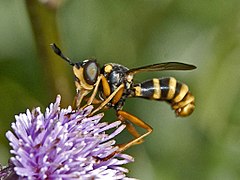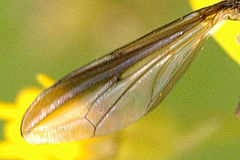
The Conopidae, also known as the thick-headed flies, are a family of flies within the Brachycera suborder of Diptera, and the sole member of the superfamily Conopoidea. Flies of the family Conopidae are distributed worldwide in all the biogeographic realms except for the poles and many of the Pacific islands. About 800 species in 47 genera are described worldwide, about 70 of which are found in North America. The majority of conopids are black and yellow, or black and white, and often strikingly resemble wasps, bees, or flies of the family Syrphidae, themselves notable bee mimics. A conopid is most frequently found at flowers, feeding on nectar with its proboscis, which is often long.

Helophilus pendulus is a European hoverfly. Its scientific name means "dangling marsh-lover". It is a very common species in Britain, where it is the commonest Helophilus species. It is found throughout Europe from the Mediterranean to Scandinavia, westward to the Faroe Islands and Iceland, and through eastward through Russia from the Kola Peninsula south to Crimea and across Siberia to the Pacific Ocean.
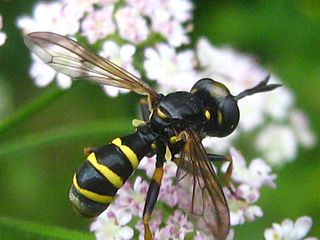
Conops is a genus of flies from the family Conopidae. The larvae of Conops are parasitic on bees, especially bumblebees. Adults feed on nectar.

Conops is a subgenus of flies from the genus Conops in the family Conopidae.
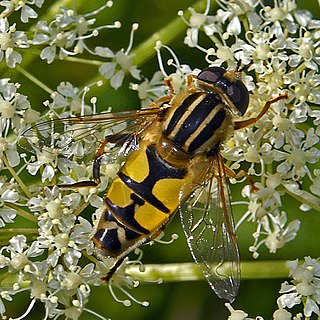
Helophilus trivittatus is a species of Palearctic hoverfly.

Baccha is a genus of hoverflies in the subfamily Syrphinae. They are typically moderate sized with wasp-like bodies. Their larvae are predatory, often on aphids.

Tachina fera is a species of fly in the genus Tachina of the family Tachinidae. It was first described by Carl Linnaeus in 1761.
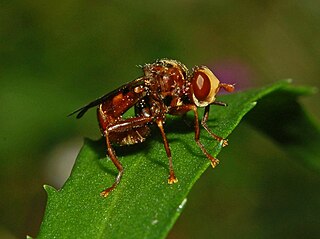
Sicus ferrugineus is a species of fly from the genus Sicus in the family Conopidae.
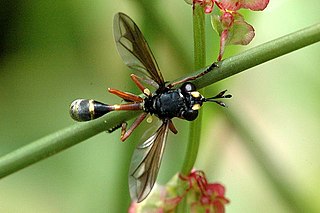
Physocephala rufipes is a species of fly from the genus Physocephala in the family Conopidae. Their larvae are endoparasites of bumble bees of the genus Bombus. It is common throughout much of Europe.

Conops flavipes is a species of fly from the genus Conops in the family Conopidae. Their larvae are endoparasites of bumble bees of the genus Bombus. It is common throughout much of Europe.

Conops strigatus is a species of fly from the genus Conops in the family Conopidae. Their larvae are endoparasites of bees and wasps. The fly is scarce in the United Kingdom.

Empis tessellata is a species of dance fly, in the fly family Empididae. It is included in the subgenus Euempis.
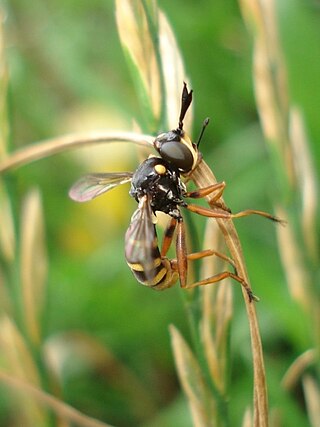
Conops ceriaeformis is a species of fly from the genus Conops in the family Conopidae. Their larvae are endoparasites of bees and wasps. The fly is scarce in the United Kingdom.

Conops vesicularis is a species of fly from the genus Conops in the family Conopidae. Their larvae are endoparasites of bees and wasps. The species is native to Europe.

Myopa dorsalis is a species belonging to the family Conopidae subfamily Myopinae.
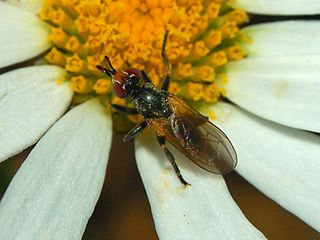
Thecophora atra is a species of small fly in the family Conopidae subfamily Myopinae.

Thecophora pusilla is a species belonging to the family Conopidae subfamily Myopinae.

Cylindromyia brassicaria is a species of fly in the family Tachinidae.

Nemoraea pellucida is a species of fly in the family Tachinidae.

